Don't wanna be here? Send us removal request.
Photo



Three excerpts from my forest battlemap project.
The first one is a mountain track with a small brook. I wanted to focus on adding minor elements that could be used by the DM to engage his players. The largest of them all is the split rock, which can be used as a story element (maybe your players are chasing something big and they make camp in the wake of the monster they have been chasing). There is also a fairy circle in the top left corner and as mentioned before a campsite that could either be used by NPC’s or by the players themselves.
The second one is based on a druidic stone circle, similar as the one in Stonehenge. It is 3 points of entry at the bottom of the circle, a stone altar surrounded by four stone pillars and an entrance that might lead players deeper into a dungeon beyond. Making it a very adaptable map.
Third is a simple bridge over a river map. One of those maps that can come in very handy when you are doing an encounter during a travelling sequence.
3K notes
·
View notes
Photo

I love these dice so much 💖 I wasn’t even intending to take a picture of them, but they looked so gorgeous in the sunlight that I had to
7K notes
·
View notes
Photo

“To the corrupted, and to the kind, their appearance would mean two different things.” (The crowned owls, personal Dungeons and Dragons concept)
2K notes
·
View notes
Text
Being obsessed with D&D means making characters with elaborate backstories and getting way too attached and then never playing them.
3K notes
·
View notes
Photo
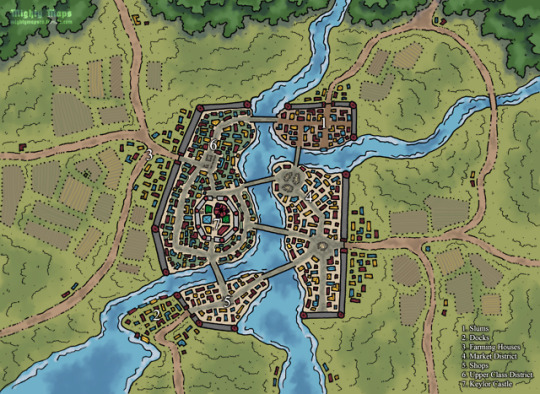
The city of Keylor- Originally just a castle on the banks of a river, used as a defensive structure. Over the years its grown and blossomed into a fully fledged city; with exterior walls, docks that lead out into the ocean, sprawling farm lands and its own social and political hierarchy. However growth has its own problems; slums and areas that can’t keep up with other parts of the city, walls that stretch across rivers that aren’t fully protected, a growing underground and attracting unwanted attention from creatures in the forest to the North.
1K notes
·
View notes
Photo
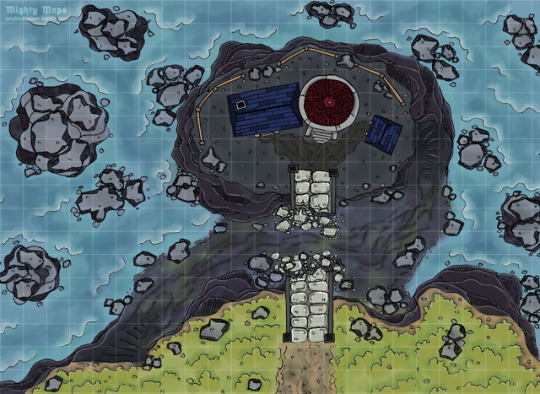
Loud rumblings from outside the town just so happened to coincide with the lighthouse bridge falling deep into the ravine. Now, the light has stopped and no word from the lighthouse keeper. Someone needs to work out whats happened and get that light on before the next scheduled ship arrives and meets a fate upon the rocks. If your players decide to try and run through the ravine and under the bridge, the tide comes flooding in ever second turn. This requires a strength check to see if your players can stand against it, or risk being swept out to sea.
I’m doing free maps for the first 10 people to sign up for my $5 pledge over on PATREON. You also get gridded/clear, day/night/etc, plus access to my PSDs and print-ready files.
123 notes
·
View notes
Photo


Bard College: College of the Herald
Just like the Lightbringer from last time, the exact inspiration for this subclass is hard to pin down. It’s more like an amalgamation of many concepts and characters from games and stories that I have found interesting. The basic concept of this bard is someone who uses a polearm (often with a flag or banner tied to it) and inspires larger groups of people by telling stories of similar situations in history where great heroics managed to overcome almost impossible odds.
I’m going to try going weekly, so expect a new homebrew as soon as next weekend, probably saturday. I still have some more material in the backlog ready for release so I thought it would be unnecessary to space it out by a whole two weeks between each time.
193 notes
·
View notes
Text
Bards are too powerful. They can learn mass suggestion. All they have to do is yell “Everybody clap your hands!” and make up to 12 people do the Cha Cha slid for 24 hours
68K notes
·
View notes
Photo

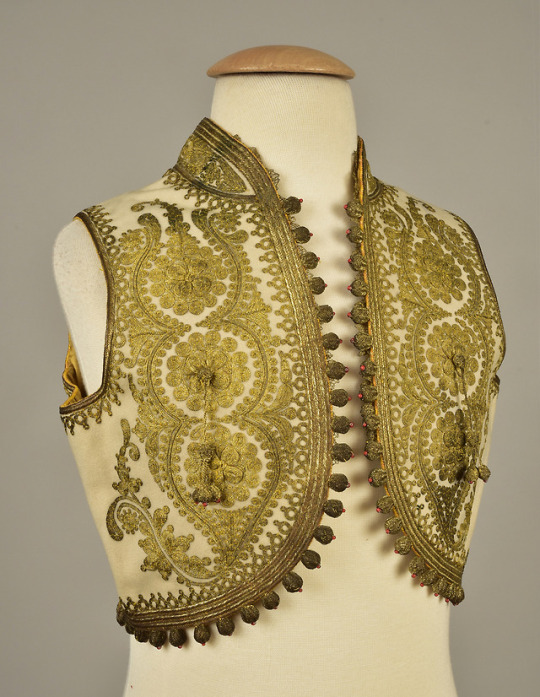
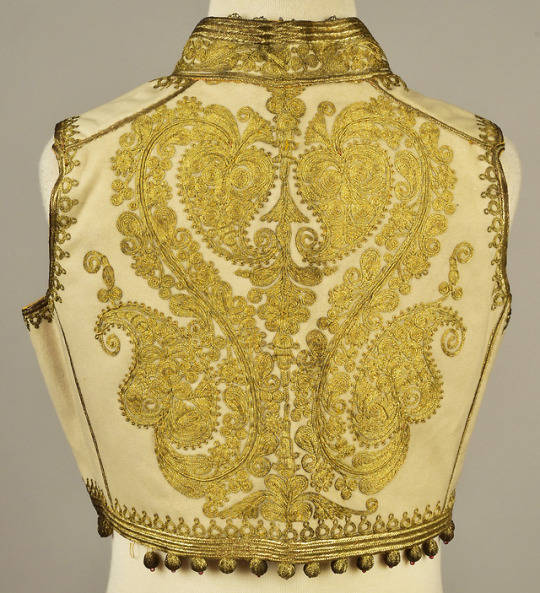
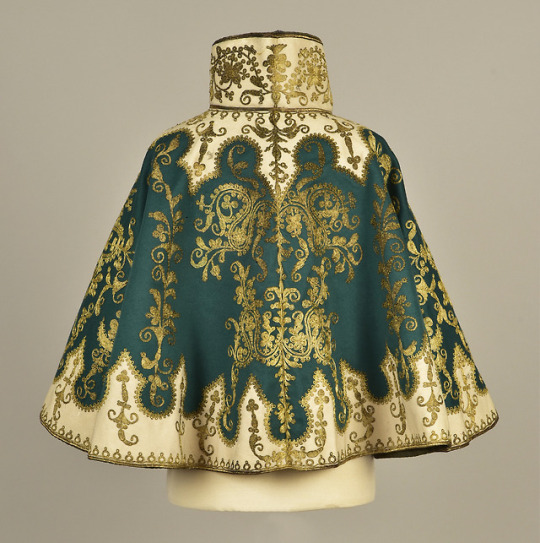
Ottoman cape and vest, 1890′s
From Whitaker Auctions
28K notes
·
View notes
Note
What tips do you have for formulating a campaign? Do you prefer pre-made modules or home few?
Pre-made adventures or campaign settings are only useful if A) they’re easier/faster than coming up with something yourself would be, or B) you have a lot of free time to read a game book and memorize all of its details.
My advice?
1) Have your first session start with the players waking up in a dungeon you made. No other details, no plot, no story, just “We’re stuck, we need to work together to get out of here”. This way, you don’t need to come up with a whole world before playing your first game. If you have some campaign ideas already, you can pepper them in throughout the dungeon crawl.
Don’t let not having a whole campaign ready to go stop you from playing D&D. Chances are your players won’t care.
2) Take a 8.5x11 piece of paper. You’re gonna use it to make a map.
3) Roll a handful of dice onto the paper. Four d6′s, two d10′s, a d20, and a handful of d4′s work best. Make sure they’re kinda spread out when rolled. If they’re too bunched up, roll them again.
4) Now…each dice and their number rolled corresponds to a location on your map. d4′s are ruins, d6′s are dungeons/strongholds, d10′s are small towns, the d20 is a city. Now you have a bunch of places for your players to go to.
5) The number rolled on each of the dice determines the specific type of location it is. They break down like so:
Ruins (d4):
A razed village, burned to the ground. 50% chance of their being treasure under some floorboards.
A centuries old elven landmark.
A centuries old dwarven landmark. Buried treasure.
A broken obelisk of almost alien design. Either portal to another plane, or a camp for important monsters.
Dungeons/strongholds (d6):
Old tomb. Undead.
Basement of ruined castle.
Abandoned and cursed temple. Weird cultists.
Arcane Tower. Crazy old wizard.
Old Fort. Full of monsters or jerk humans.
Death Trap. Has a lich. Leads down into a bigger megadungeon.
Towns (d10′s):
Multiply the roll by 20. That’s the population. The roll is also the level of the highest level NPC in that town.
1-3. Agricultural town. Everywhere nearby is good farmland.4-5. Fishing/trade town. A river runs through the town and through the map.6. Lake town. Same as above, but the town is in the centre of a huge lake. Rivers extend from it.7. Gate town. Sits at the base of a mountain range. Is a gateway to a mountain pass.8. Cut-throat town. Full of shady thieves and villains. Basically a town-sized dungeon crawl.9. Demi-human town. Run by mostly good halflings, dwarves, or elves.10. Monster town. Town run by monstrous people like orcs, goblins, skeletons, etc.
City (d20):
This is the biggest settlement in the immediate campaign world. It is generally a place the players will want to get to, as it’s the best place to sell treasure, buy dog armour, and get curses removed. The roll x100 is the permanent population, but it’s probably double that with visitors. The roll is also the level of the NPC in charge of that town. If it’s really low, that person is either a simpleton or a child.
1-3. God fearing city. Leader is a theocrat. Magic is treated with more hate than usual. Temples are abundant. Brothels and Festhalls also abundant, but hidden.4-5. Slum city. Leader is a thief/despot. Collection of shanty-towns. Full of shady characters. Great place to fence goods and buy weird items.6-8. Villain city. Leader is a campaign villain. She/he keeps the common people downtrodden and will try to exert her/his authority over the players in petty ways. 9-11. Monarch city. Leader is a noble (viscount, duke, baron, etc). Peace is kept with a town guard. Knights are common and welcomed here. Adventure hooks can be passed down from the monarchy on high.12. Ruin city. Leader is a mayor. Buildings are a collection of towers built on top of a much older ruined city. There’s a dungeon below.13. Magic city. Leader is a magister. Home of a magic college or ruling wizard class. Anything can be bought/sold here. Oddities and strangeness are abundant.14. Elven city. Leader is a high elf noble. The campaign map is under elven rule. That rule may be waning. Lots of trees, stained glass, dueling in the streets.15. Dwarven city. Leader is a cabal of dwarven trade concerns. The campaign map is under dwarven rule. That rule may be waning. Partially underground, great armour, maybe lava flows.16. Halfling city. Leader is a halfling matron. The campaign map is under halfling rule. That rule may be waning. Lots of hills, all the buildings are meant for shorter people, the food is great.17. Invasion city. Leader is a foreign invader. This native city has been seized by a foreign power and is in the throes of occupation/rebellion. The players can pick a side if they want.18. Devil city. Leader is a secret devil prince/princess. Clearly full of evil creatures and bad folks. Not hostile, but evil. Trade is great. Brothels are excellent. No non-evil temples.19. Giant city. Leader is a frost giant prince/princess. The city is built and intended for giant creatures, but open to smaller folk. Trade is ridiculous.20. Ghost city. Leader is a lich. Built on top of an ancient mausoleum. Ghosts and humans interact normally, using each other for mutual gain. Everything is spooky.
6) Now that you have all your locations, connect them with roads, rivers, and paths. Fill in empty spaces with forests, deserts, coastlines, etc. The types of towns and cities you rolled should dictate the environment.
7) The dungeon that is furthest away from the city is the one your players woke up in. That’s where they start on the map.
8) Come up with names for all the locations. Fill in the details. Adjust to your own tastes. Now you have a ready made campaign world with an implied history and geography. Have fun watching your players systematically dismantle it in the most ridiculous ways possible.

2K notes
·
View notes
Text
Creating A Pantheon
I’ve begun fleshing out the setting for my secondary Dungeons & Dragons campaign. It’s a less serious game and is a pretty traditional fantasy setting a la Lord of the Rings and vanilla D&D. Today I worked on creating gods. I wanted to share how I’ve started doing my deities, as I’ve found it can provide some fun or interesting combinations.
I’m playing 5e, so I’ve pulled out the eight different divine domains that are in the books (the seven from the Players Handbook plus the Death domain present on other pantheons listed in the Dungeon Master’s Guide). This is a simpler list than one would find in 3.5, but the idea will work across editions –and even game systems).
Once you have a list of the different domains that your gods will represent, number them and then pull out two dice of that number (luckily I have only eight domains, if you have a strange number of them you may need to use an online dice roller that lets you input custom sides).
Here’s my list of numbered domains:
1. Knowledge
2. Nature
3. Life
4. Tempest
5. Light
6. Death
7. Trickery
8. War
Now I simply rolled my two dice and picked what domains those were, and then made a god that represented them. My first roll was easy, Life and Knowledge. I decided to make this a god I had already made up for a dwarven NPC, it was Mordheim the dwarven god of the forge, creator of dwarves and similar folk. This one wasn’t too exciting or unique, but it fits my more traditional setting.
Next I got Death and Light. Interesting…I’d not thought of this combination as working well, but it inspired an idea. We’ve all heard of ‘the light at the end of the tunnel’, yeah? Maybe this god is what inspires that phrase. I came up with the idea that this worlds reaper would be a silent woman in a white robe, who carries a lantern on a stick. It’s kind of creepy and unsettling, and is a bit more flavorful than your normal reaper. I’m imagining there’s probably a candle theme going to occur with her.
I won’t go through the entire list, but here’s a couple more of note. One god I got was War and Nature. I decided this could be more of a viking god, in tune with the primal energy of earth, but barbaric and aggressive. And another I rolled the same number twice. At first I was inclined to reroll one of the die, but realized that perhaps having a deity with a single domain would mean that that singular thing would be an intensified theme for that god. For this I rolled light twice, so I decided to make it a sun god who is probably going to be a dragon that created the sun in this setting.
Not all ideas are super unique, but this randomized way of creating your pantheon can lead to some interesting combinations and let’s you think of clever was to try and incorporate two (or more) domains together into a god, and what that god means to your setting.
I will probably post my pantheon later, and I’ll be back with more DMing thoughts! Please let me know what you think!
937 notes
·
View notes
Photo

Given how poorly my characters roll for Con saves they’re unconscious a lot…
1K notes
·
View notes
Photo


Finished dungeons and dragons character commission! Zrak Strongscar, the Kobold paladin that wears a shield for a helmet for @pokemontrainercelest
831 notes
·
View notes



